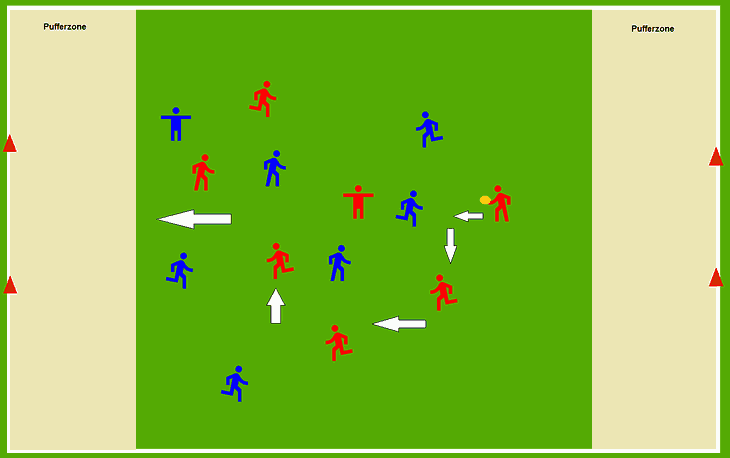source: www.youthwork-practice.com | 2000 Games, Devotions, Themes, Ideas and more for Youth Work
only for private using
Rugby interception
Overview
- Submitted by: Timm Ody
- Participants: 12-24
- Age: (10) 12-30
- Time: 20-45min
- Venue: large hall, soccer field (grass)
Rugby interception is a peaceful variation of classic rugby developed by Timm Ody. It was created by mixing and adapting rugby and flag football aspects and was initially designed for athletics training.
Rules
Rugby interception is a running-intensive game that is ideal for getting kids, teens, and adults up to speed. It is played with rugby or football, which may be unfamiliar to most and has a high-demand character. The rugby version is suitable for children 10 years and older. To ensure a smooth flow, the athletes should have already gained some experience in other ball sports. From about 12/13 years, it can be assumed that the necessary team tactical aspects (e.g., free running) can be implemented well. Depending on the number of players and the desired effect, the size of the playing field can vary greatly. Figure 1 shows an exemplary setup for 16 players (8 vs. 8). The larger the playing field, the more endurance-intensive the game becomes. In particular, the width of the area (sidelines) should be generous to improve the flow of the game. Since it is hard to play in a too narrow space, the size of the playing field should be at least 40 x 40 meters. Even if the number of participants is small (see also "Variation possibilities").
Technique
The game's goal is for a player to run with the ball into the opponent's end zone. If the player with the ball is touched (as in catching, not tackled!), he must stop immediately and pass the ball to one of his teammates in the back (!). He must not be obstructed when throwing, but the flying ball is free. If the ball is deflected to the ground or the teammate cannot catch it, the opposing team receives it. He starts his move at the point where the ball touched the ground. Passing the ball forward also changes the possession of the ball. If a player with the ball runs through the opponent's goal into the end zone, his team receives a point. The restart after scoring a point is always from the team's own baseline. In addition, the following rules apply:
-
In the own buffer zone (approx. 5m), the team with the ball may not be attacked. Also, a loss of the ball (e.g., by not catching a pass) has no consequences in this area. This allows for a smooth build-up of play.
-
Tackling, pushing, shoving, hitting, etc., are not allowed. High-fives are only allowed with a flat hand.
-
The ball may not be knocked out of the hand.
-
Crossing the baseline to the left and right of the end zone is not allowed and will result in a change of the ball.

Rugby interception pitch (the pitch dimensions must be adjusted individually depending on the circumstances (pitch size, number of players, etc.)
©: www.youthwork-practice.com / Submitted by: Timm Ody
Variations
Defending the field
Form four teams of three to five players each. Two teams compete against each other; the other two can do exercises or similar on the edge of the field. If a goal is conceded, the losing team must leave the field. After three minutes without scoring, both teams are swapped. If only one group is replaced, the team that waits longer gets a go.
Solo run
If a player manages to run from his own baseline into the opponent's end zone without being touched by the opponent, his team receives 5 points. If a team manages to run from the baseline to the end zone without losing the ball, it receives three points.
Submitted by: Timm Ody
[ © www.youthwork-practice.com | 2000 Games and Ideas for Youth Work ]






